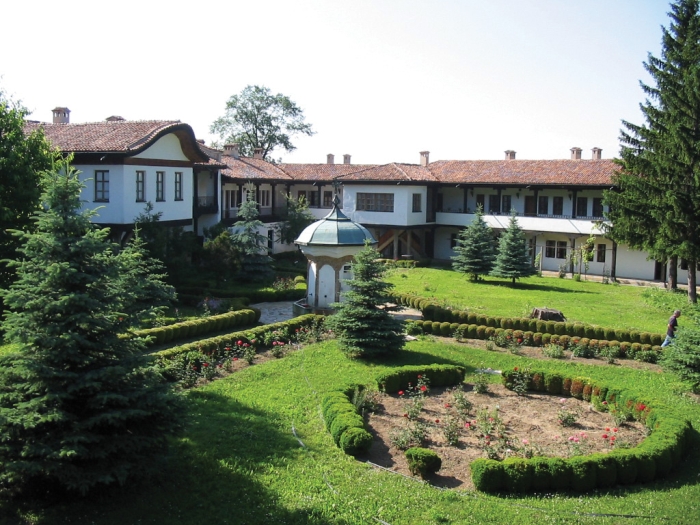 
Sokolksy
Monastery
Sokolksy
Monastery is hidden away in one of the most beautiful spots of the Gabrovo
Balkan. At the beginning of the 19th century the cave near the present-day
church was the sanctuary of two monks – Joseph and Agapius of the Troyan
Monastery. Their solitude was shared by the many falcons which nest in
the rock crevices and which have given the monastery its name (‘falcon’
is ‘sokol’ in Bulgarian). The monastery was founded by Arch Deacon Joseph
Sokolksy whose highly eloquent rhetoric convinced the Turkish rulers that
the monastery had existed well before the conquest. In 1834 with help
from the local population a church was built in front of the cave which
replaced the timber shrine. The church was painted by Constantin of Peshtera.
The interior and porch were created by Pavel Zograph and his son Nichola
from the neighbouring Shipka village. Icons by Zachary Zograph, old books
of prayer, personal belongings and photographs of the wounded Russian
officers who came to the monastery for treatment during the Russian-Turkish
Liberation War are preserved in the church.
Sokolksy
Monastery is hidden away in one of the most beautiful spots of the Gabrovo
Balkan. At the beginning of the 19th century the cave near the present-day
church was the sanctuary of two monks – Joseph and Agapius of the Troyan
Monastery. Their solitude was shared by the many falcons which nest in
the rock crevices and which have given the monastery its name (‘falcon’
is ‘sokol’ in Bulgarian). The monastery was founded by Arch Deacon Joseph
Sokolksy whose highly eloquent rhetoric convinced the Turkish rulers that
the monastery had existed well before the conquest. In 1834 with help
from the local population a church was built in front of the cave which
replaced the timber shrine. The church was painted by Constantin of Peshtera.
The interior and porch were created by Pavel Zograph and his son Nichola
from the neighbouring Shipka village. Icons by Zachary Zograph, old books
of prayer, personal belongings and photographs of the wounded Russian
officers who came to the monastery for treatment during the Russian-Turkish
Liberation War are preserved in the church.
The
icons at the altar were painted by the famous Tryavna icon painters –
Ruka Simeon and Joanicus Papa Vitan who painted the famous Three-arm Virgin
- believed to have healing power. The monastic wing and a spacious walled-in
courtyard were built in 1836 on the plateau above the church. This is
the only monastery in Bulgaria which instead of a church facing the main
gate has a fountain with eight spouts shaped as falcon heads. It was built
in 1868 together with the stonewall by the famous master-builder Kolyo
Ficheto.
Built
as a fortress, the monastery was a starting point for many rebel gangs
who roamed the mountains fighting the Turkish oppressors and striving
to bring freedom to the country. A monument of culture of national significance.
|

